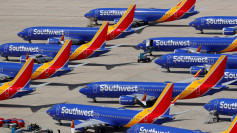Boeing Co. delivered 33 jets in September, a decrease from the 40 aircraft it handed over in August, as the ongoing machinist strike weighs heavily on its production capabilities. The strike, which began on September 13, involves around 33,000 workers at Boeing's U.S. West Coast factories and has significantly impacted the assembly of the company's best-selling 737 MAX jets, as well as its 777 and 767 widebody aircraft.
The delivery numbers, while slightly improved compared to the same period last year, reflect a broader struggle for the aerospace giant. In September 2023, Boeing delivered only 27 aircraft due to lingering effects of a manufacturing defect that plagued its 737 MAX production line. However, despite the uptick from last year, Boeing's year-to-date performance is still underwhelming. The company has delivered 291 aircraft so far this year, significantly lower than the 371 jets it had delivered by this time in 2023, while its main competitor Airbus has managed to deliver 447 aircraft through August.
The majority of Boeing's September deliveries consisted of 27 737 MAX jets, with key customers including United Airlines, which received five jets, and Ryanair and Southwest Airlines, which each took delivery of three. These deliveries are critical to Boeing's financial health, as the company receives the bulk of payment for an aircraft upon its transfer to the customer. "Investors closely watch delivery numbers, as airplane makers receive the majority of payment for a jet when it is transferred to a customer," noted Jefferies aerospace analyst Sheila Kahyaoglu.
Production challenges are set to continue as the machinist strike drags into its fourth week. The strike began after Boeing workers voted down a proposed contract, prompting concerns about further delays in the production ramp-up of the 737 MAX. Boeing had initially planned to increase its production rate to 38 MAX jets per month but is now expected to maintain a lower output of 25 aircraft per month if the strike ends in October, according to Kahyaoglu. This delay represents a significant setback for Boeing, which has been aiming to accelerate production to meet rising demand from airlines.
Aside from the challenges posed by the strike, Boeing's output was also affected by ongoing quality control issues. The company faced a near catastrophe earlier this year when a door plug on one of its new 737 MAX 9 jets malfunctioned, highlighting lingering concerns over its production standards. Despite these setbacks, Boeing logged a solid 65 gross orders in September, including 54 737 MAXs and 11 777 freighters for unidentified customers. The China Development Bank Financial Leasing's order of 50 Boeing MAX jets provided a much-needed boost to Boeing's order book.
Boeing's total order count through September 30 rose to 315, with a net total of 272 orders after accounting for cancellations and conversions. Following further accounting adjustments, Boeing reported an adjusted net order tally of 121 airplanes for the year. The company's backlog remains robust at 5,456 aircraft, indicating strong future demand even as current production is hampered by labor disputes and manufacturing issues.
In addition to the 737 MAX jets, Boeing delivered four 787 Dreamliners in September. These planes are manufactured in Boeing's nonunion facility in South Carolina, which has so far remained unaffected by the labor unrest impacting its West Coast operations. The 787 Dreamliner has become increasingly vital for Boeing as it continues to navigate through production and delivery challenges in its other aircraft lines.
Looking ahead, Boeing is expected to provide a detailed financial update on October 23, when it releases its quarterly earnings report. Analysts and investors will be watching closely for insights into the strike's impact on Boeing's finances and how the company plans to address the production shortfalls that have affected its ability to meet delivery targets.






